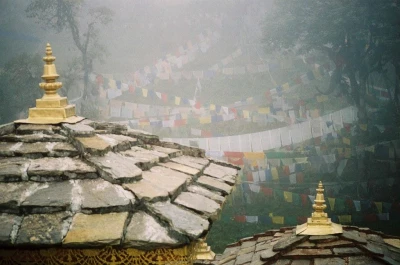
Explore the Culinary Delights on Your Bhutan Adventure Journey
- 1. Influences on Bhutanese Cuisine: A Melting Pot of Flavors
- 2. Staple Foods of Bhutan
- 3. Must-Try Dishes in Your Bhutan Adventure Travel
- 4. Regional Variations in Bhutanese Cuisine: A Culinary Journey Across the Kingdom
- 5. Food and Culture: A Deep Connection when starting Bhutan adventure
- 6. Practical Tips for Dining in Bhutan
Delve into the Rich Tapestry of Bhutanese Cuisine! Bhutanese food is a tantalizing blend of flavors, reflecting the country's diverse geography, Buddhist principles, and historical influences. Join us on a culinary journey through Bhutan adventure and immerse yourself in a world of deliciousness that will ignite your taste buds and leave you craving more.
1. Influences on Bhutanese Cuisine: A Melting Pot of Flavors
Bhutan's cuisine is a fascinating blend of influences, reflecting the country's unique position at the crossroads of Asia. Here's a glimpse into the factors that have shaped Bhutanese food culture:
- Geography and Climate: Bhutan's diverse landscape, ranging from snow-capped peaks to fertile valleys, plays a crucial role in defining available ingredients. Rice thrives in the valleys, while maize (corn) is a staple in the higher altitudes.
- Buddhist Principles: Bhutan's deep Buddhist roots are reflected in the emphasis on vegetarian options and dairy products. Non-violence and respect for all living beings influence the use of ingredients.
- Neighboring Cultures: Bhutanese cuisine shares some culinary influences with its neighbors. Tibetan influences are evident in the use of yak butter and momos (dumplings). Indian spices and Nepalese dishes like sel roti (fried bread) also find their place on Bhutanese tables.
2. Staple Foods of Bhutan
Explore the culinary wonders on your Bhutan adventure! Bhutanese cuisine is a delightful fusion of essential ingredients, each playing a crucial role in crafting delectable and fulfilling meals:
- Rice: The king of Bhutanese staples, consumed with most meals. Red rice, with its nutty flavor and high nutritional value, is a popular variety.
- Maize (Corn): A vital source of carbohydrates, especially in higher altitudes. Maize is used in flatbreads, dumplings, and even a local alcoholic beverage called "chang."
- Chili Peppers: The defining feature of Bhutanese cuisine! Chili peppers add heat and a distinct flavor profile to most dishes. Ema Datsi (chili peppers with cheese) is the national dish, a testament to the love for spice.
- Dairy Products: Butter, cheese (datshi), and yogurt are widely used in curries, stews, and as dipping sauces. Yak butter, with its rich flavor, is a prized ingredient in many dishes.
Buckwheat: Grown in some regions, buckwheat is used for noodles (soba) and savory pancakes (phakshapa).
3. Must-Try Dishes in Your Bhutan Adventure Travel
Bhutanese cuisine offers a delightful adventure for the adventurous foodie. Prepare to tantalize your taste buds with these must-try dishes:
- Ema Datshi (National Dish): Spicy stir-fried chili peppers with cheese curds, the heart and soul of Bhutanese cuisine. Ema Datshi is a fiery and flavorful dish, often served with rice.
- Kewa Datshi: Comfort food at its finest! Potatoes simmered with cheese curds create a creamy and mildly spiced dish, offering a comforting alternative to Ema Datshi.
- Shakam Ema Datshi: For the truly adventurous eater, Shakam Ema Datshi combines dried beef with chili peppers and cheese. This hearty dish is a powerhouse of flavor and texture.
- Phaksha Paa: Craving meat? Phaksha Paa is a pork stew simmered with radish and chilies, offering a satisfying and flavorful option.
- Momos: These beloved dumplings, filled with meat, vegetables, or cheese, are a popular snack and appetizer. Steamed or fried, momos are a delicious way to experience Bhutanese street food.
- Jasha Maru: This spicy chicken stew with onions, tomatoes, and garlic is a perfect dish for colder nights. Jasha Maru is guaranteed to warm you up from the inside out.
- Suja: No Bhutanese meal is complete without Suja, the unique Bhutanese butter tea. Made with yak butter, salt, and black tea. This is an acquired taste, but it offers a glimpse into Bhutanese traditions and hospitality.
4. Regional Variations in Bhutanese Cuisine: A Culinary Journey Across the Kingdom
Just like its diverse landscape, Bhutanese cuisine offers regional variations that reflect the unique ingredients and cultural influences of different areas:
- Eastern Bhutan: Known for its fiery dishes, eastern Bhutan embraces the heat! Bird's eye chilies add an extra kick to their Ema Datshi, and spicier variations of curries are prevalent. Explore these culinary delights as part of your Bhutan cultural tours, experiencing the region's unique flavors firsthand.
- Western Bhutan: Influences from neighboring Nepal are more evident in western Bhutan. Momos and sel roti (fried bread) are popular staples, and dishes may be slightly milder compared to the east. Incorporate a visit to western and savor the culinary influences that have shaped this region.
- High-Altitude Regions: Barley takes center stage in the high-altitude regions of Bhutan. Barley flour is used for flatbreads and a local beer called "chang," a unique and slightly sour beverage. Discover these unique ingredients and flavors as you explore the high-altitude regions.
5. Food and Culture: A Deep Connection when starting Bhutan adventure
Food is more than just sustenance in Bhutan; it's deeply intertwined with the country's culture and traditions:
- Festivals and Ceremonies: Special dishes are prepared for Tshechus (festivals) and other important occasions. These dishes hold cultural significance and reflect religious customs.
- Social Gatherings: Sharing meals is a way of life in Bhutan. Families and communities gather to eat together, fostering a strong sense of connection and belonging.
- Home Cooking: Traditional recipes are passed down through generations, preserving cultural heritage and ensuring the continuation of unique culinary styles.
>>> Read more: Exploring Nepal and Bhutan: A One-Week Itinerary with Full Guide
6. Practical Tips for Dining in Bhutan
Bhutan offers a unique dining experience for adventurous foodies. Here are some practical tips to help you navigate mealtimes:
- Spice Level: Bhutanese cuisine can be quite spicy. Inform your host about your preferred spice level when ordering food. They can adjust the amount of chili peppers accordingly.
- Etiquette: Use your right hand for eating. Chopsticks are sometimes used, but not as frequently as in neighboring countries. Avoid pointing your chopsticks at others; it's considered impolite.
- Dining Options: Restaurants in tourist areas offer a mix of Bhutanese and international cuisine. For a more authentic experience, consider staying at homestays where you can enjoy home-cooked meals prepared with fresh local ingredients.
Bhutanese cuisine is a vibrant tapestry of flavors, steeped in tradition and shaped by the breathtaking Himalayan landscape. From the fiery Ema Datshi to the comforting Kewa Datshi, each dish offers a unique taste of Bhutanese culture and heritage.

So, lace up your hiking boots, pack your adventurous spirit, and embark on a Bhutan adventure tour. Explore the majestic peaks, immerse yourself in the rich cultural tapestry, and embark on a culinary journey that will tantalize your taste buds and leave you with memories that will last a lifetime. Bhutan awaits, ready to offer you a taste of the Himalayas unlike any other. Join Adventure Asia now!
- 1. Influences on Bhutanese Cuisine: A Melting Pot of Flavors
- 2. Staple Foods of Bhutan
- 3. Must-Try Dishes in Your Bhutan Adventure Travel
- 4. Regional Variations in Bhutanese Cuisine: A Culinary Journey Across the Kingdom
- 5. Food and Culture: A Deep Connection when starting Bhutan adventure
- 6. Practical Tips for Dining in Bhutan





















